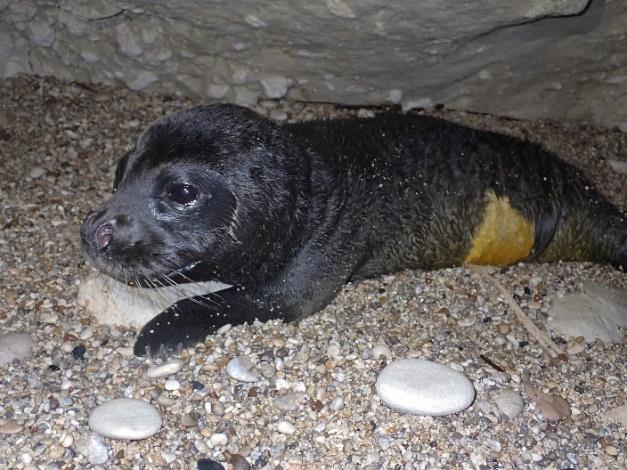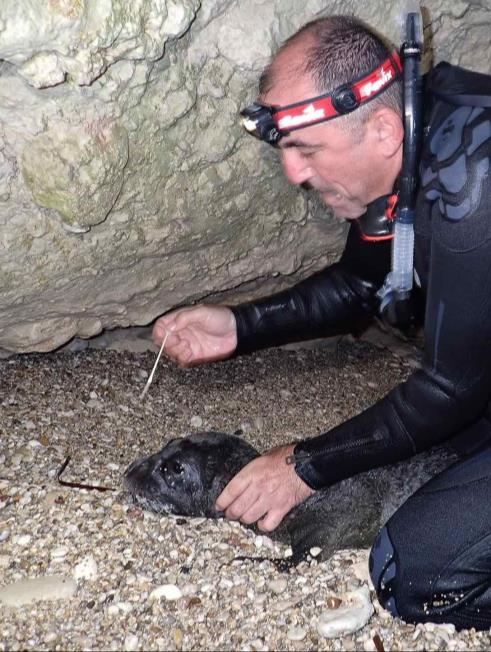Filenews 19 February 2024 - by Angelos Nicolaou
The rarest marine mammal in Europe and one of the rarest in the world, the Mediterranean monk seal Monachus monachus, after an absence of decades in recent years, is permanently observed breeding in Cyprus.
The Ministry of Agriculture, Rural Development and Environment is satisfied that during the breeding season of 2023 of the species Monachus monachus, two more births of this rare marine mammal have been recorded on our island, raising the total number of individuals to about 22. It is noted that a few years ago their number reached 12. These two births concern the areas of Akrotiri and Akamas/Halavros. The newborn seals were given the names "Pieros" and "Arcadia". Pieros was born in November 2023 from Hydilis and Arcadia on October 4, 2023 from Anassa. Unfortunately, Arcadia was found dead yesterday Saturday in the Gulf of Polis Chrysochous. The exact cause of death will be determined after an autopsy which will be carried out in the middle of the week. Births are considered an extremely important event for the conservation of the species in Cyprus, but also for the effectiveness of nature protection and management programs in our country.
The Mediterranean Monk Seal Monitoring Team in Cyprus has recorded all the shelters used by the species, throughout the coastline of the free areas of our island. In fact, with the help of special equipment, monitoring is 24 hours a day, while one shelter enables real-time monitoring. The monitoring team collects information concerning the behaviour of the species (e.g. reproduction, frequency of presence, condition of animals), in order to study the conservation of its population in Cyprus and its gradual increase.
In the first months of their lives, the little seals spend almost all day inside the cave. Gradually, they begin to move away accompanied by their mother, following her in finding food. After the end of the lactation period, which lasts about 3 to 4 months, the young animals will become independent from their mother, without necessarily leaving the cave in which they were born.

The first period of life of newborns is an extremely critical period for their survival, since the risks they face are many. Although newborns are able to swim from the first days of life, they are neither strong nor experienced enough to cope with severe rough seas, so they are at great risk of drowning, especially if their mother cannot protect them or if the shelter does not provide adequate protection.
It is for this reason that it is extremely important that breeding shelters are kept away from human disturbance, since in such a case newborns may be disturbed by human presence and attempt to escape the danger of getting out of the safety provided by the cave. The premature exit of newborns from the cave entails, as mentioned earlier, the serious risk of drowning, since they will not be able to swim for a long time, or they could even to go out to a remote beach, away from their mother and die of starvation or other dangers. In addition, due to human disturbance, the mother may remove the newborn to another shelter that does not provide the safety of the original shelter, resulting in a serious risk of drowning from severe rough seas.
In addition to the above, the risks for young animals in the sea are many, mainly due to inexperience, with the highest mortality rate in this species recorded during their first year of life.

Decrees establishing marine protected areas
In the last 12 years it has been established that the Mediterranean monk seal uses sea caves of the Cypriot coastline for breeding and rest. In order to protect this emblematic species, among other measures, decrees have been issued creating protection zones around the area of the Sea Caves in Pegeia and the area of Halavros in the Akamas peninsula, in which fishing is prohibited, as well as the passage of motor boats.
Also, by decision of the Minister of Agriculture, a process is underway for the expropriation of plots that are very close to breeding shelters of the species and their development would cause serious nuisance issues for the species. Some of the measures for the protection of the Mediterranean monk seal are fully in line with the recommendations made in a report by the expert scientist on the conservation of the species, Dr. Panagiotis Dendrinos.
It is noted that the Greek scientist, Dr. Dr. Dendrinos, President of the Hellenic Society for the Study and Protection of the Mediterranean Monk Seal (MOm), will be a speaker next Saturday 24/2/2024, at an event to be held at Cap St Georges in Agios Georgios, Pegeia, organized by the Municipality of Pegeia and the Ministry of Agriculture, Rural Development and Environment. The event is under the auspices of Minister Maria Panayiotou and a presentation on the conservation of the Mediterranean monk seal in Cyprus will be made by the members of the Mediterranean Monk Seal Monitoring Group in Cyprus, Haris Nicolaou and Melina Markou.
The aim of the measures and the resulting decrees is the protection and proper management of biodiversity in the areas where the species is found, with a view to the harmonious coexistence of seals with humans.
In addition to the above measures, a very innovative action, unique at European level, concerns the restoration of a sea cave that had collapsed in the Limassol district, which was a refuge for the Mediterranean monk seal in the past, with the result that today the animals have returned to this cave and use it successfully since 3 different seals are recorded to use the cave.
The most frequent recordings
The most frequent recordings mainly concern the areas of Ayia Napa Sea Caves, Governor's Beach, Agios Georgios Alamanos, Akrotiri Limassol, Pegeia Sea Caves and Akamas Peninsula.
Also, sightings of the species have been recorded in the ports/fishing shelters in Ayia Napa, Zygi, Limassol, Pegeia, Latchi, and Pomos, as well as the fish farming areas such as those in Liopetri, Vasilikos and Ladies mile. Ports and fishing shelters continue to be places of refuge during periods of unsettled weather and rough seas, especially for young pups who are not so experienced in such weather phenomena.
It is obvious that aquaculture units are feeding areas since fish are gathered around them that benefit from feeding. This is something that can also be seen in the recordings from the database.
